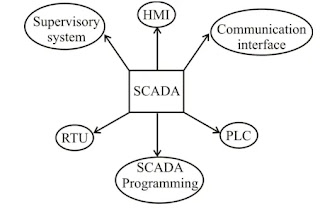Introduction to SCADA
SCADA stands for Supervisory Control and Data Acquisition. It is a powerful system used across industries to remotely monitor and control machines, processes, and equipment in real-time. SCADA is essential in automation industries such as manufacturing, energy, oil & gas, water treatment, and transportation.
With SCADA, operators can supervise entire industrial operations from a single control point, ensuring efficiency, safety, and uptime.
SCADA Block Diagram and Components
A SCADA system is typically divided into five key components:
1. Field Instrumentation
These are the sensors, flowmeters, and transducers installed directly on machines and equipment to monitor process variables like pressure, temperature, and flow.
2. Field Controllers (RTUs/PLCs)
Remote Terminal Units (RTUs) and PLCs gather data from field instruments and convert signals into actionable information. They act as intermediaries between hardware and software systems.
3. Human-Machine Interface (HMI)
The HMI is the dashboard or interface where operators visualize data, send control commands, and monitor the performance of the system. It serves as the master supervisory tool in the SCADA architecture.
4. Network Connectivity
SCADA systems rely on reliable network connectivity using field buses, protocols (such as Modbus, Profibus, Ethernet/IP), and communication channels to ensure real-time data transmission across components.
5. Database or Historian
The historian (or data logger) securely stores collected and processed data either in cloud-based platforms or on-premise servers. This enables trend analysis, predictive maintenance, and long-term reporting.
Generations of SCADA Systems
SCADA technology has evolved through four distinct generations:
- 1st Generation: Monolithic SCADA (mainframe-based, isolated systems)
- 2nd Generation: Distributed SCADA (LAN-based, decentralized control)
- 3rd Generation: Networked SCADA (WAN/internet-based, integrated systems)
- 4th Generation: IoT-enabled SCADA (cloud, smart sensors, big data)
SCADA vs Other Automation Types
Comparison of Automation Types
| Automation Type | Advantages | Disadvantages |
|---|---|---|
| Fixed/Hard Automation |
|
|
| Programmable Automation |
|
|
| Flexible/Soft Automation |
|
|
Conclusion
SCADA systems play a vital role in modern industrial automation, enabling real-time control, data monitoring, and predictive maintenance. As technology advances, SCADA continues to evolve, integrating with IoT, cloud computing, and AI-driven analytics for smarter industry operations.
Understanding SCADA is crucial for anyone involved in process control, electrical engineering, or industrial IT systems.
Frequently Asked Questions (FAQs) about SCADA
Q1. What is SCADA used for?
Answer: SCADA is used to monitor and control industrial systems remotely, such as in manufacturing, energy distribution, and water treatment plants.
Q2. What are the main components of a SCADA system?
Answer: The five main components are: Field Instrumentation, Field Controllers (RTUs/PLCs), Human-Machine Interface (HMI), Network Connectivity, and Historian/Database.
Q3. How is SCADA different from PLC?
Answer: A PLC is a field device that controls local machines, while SCADA is a supervisory system that integrates data from multiple PLCs or RTUs to offer centralized monitoring and control.
Q4. What is the role of HMI in SCADA?
Answer: The HMI allows human operators to interact with the SCADA system, visualize data, and make manual control decisions.
Q5. What are the advantages of using SCADA?
Answer: SCADA systems improve operational efficiency, enable real-time monitoring, reduce downtime, and provide valuable data analytics for decision-making.
Q6. Which industries commonly use SCADA systems?
Answer: SCADA is widely used in oil & gas, water supply, electric power, manufacturing, transportation, and food processing industries.

